Device-to-Device (D2D) Communication Explained: PDF and PPT Download
telcomatraining.com – Device-to-Device (D2D) communication is transforming the way wireless networks handle local data exchange. By enabling direct communication between nearby devices without routing through a base station or core network, D2D offers faster, more efficient, and lower-latency connections. In this comprehensive guide, you’ll learn what D2D communication is, its advantages, use cases, and how you can download our free PDF and PPT resources to deepen your understanding.
What is Device-to-Device (D2D) Communication?
D2D communication is a technology that allows mobile devices, such as smartphones, tablets, or IoT sensors, to communicate directly with each other. Unlike traditional cellular communication, where data passes through the network infrastructure (like the base station), D2D establishes a direct link between devices. This direct connection reduces network load, lowers latency, and improves spectral efficiency.
Modern cellular standards, including LTE-Advanced and 5G NR, have embraced D2D as a critical feature. In 5G networks, D2D communication underpins technologies like sidelink communication for vehicle-to-everything (V2X) and public safety networks.
Benefits of D2D Communication
- Lower Latency: Direct links reduce transmission delay, making it ideal for time-sensitive applications.
- Improved Spectral Efficiency: By reusing spectrum resources locally, D2D maximizes network capacity.
- Network Offloading: Reduces load on cellular infrastructure, particularly in dense urban environments.
- Energy Efficiency: Direct communication often requires less power than routing through a distant base station.
- Support for Critical Services: Essential for public safety, disaster recovery, and vehicular communication (V2V, V2I).
Real-World Applications
- Public Safety Communications: First responders can communicate without relying on damaged infrastructure.
- Vehicular Networks: Cars exchange safety data in real time, enabling collision avoidance and platooning.
- Proximity Services: File sharing, local messaging, and social networking without needing internet access.
- Internet of Things (IoT): Smart sensors coordinate locally to reduce uplink traffic.
Challenges in D2D Communication
While D2D communication offers many benefits, it also presents challenges:
- Interference Management: Controlling interference with cellular users is critical.
- Resource Allocation: Efficient scheduling to ensure fairness and minimize conflict.
- Security and Privacy: Protecting direct links from eavesdropping and spoofing.
Modern research and standardization efforts continue to address these challenges, making D2D a reliable component of future networks.
Download Free PDF and PPT Resources
To help you dive deeper into Device-to-Device communication, we’ve prepared a detailed PDF and an easy-to-understand PowerPoint presentation. These resources cover:
- Fundamentals of D2D technology
- 3GPP standardization
- Technical architecture and protocols
- Use cases and deployment scenarios
- Advantages, challenges, and future directions
👉 Download the PDF
👉 Download the PPT
These materials are perfect for students, engineers, researchers, or anyone looking to understand D2D communication in depth.
Conclusion
Device-to-Device (D2D) communication is a cornerstone of modern wireless systems, offering direct, efficient, and reliable connectivity between nearby devices. By reducing network load, lowering latency, and enabling new use cases like V2X and public safety communications, D2D plays an essential role in LTE-Advanced, 5G, and beyond. Don’t forget to download the free PDF and PPT to explore this exciting topic in greater detail.







